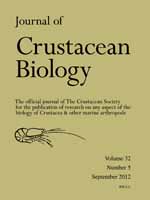Limnoperna fortunei, or the golden mussel, invaded South America through the Río de la Plata estuary in 1991. The size-selective predation on this bivalve by freshwater decapods crustaceans could be an important part of selective trophic behavior because shell sizes are correlated with the flesh contents and their resistance to being broken. The aim of the paper was analyze the size selective predation by the freshwater crab Zilchiopsis collastinensis Pretzmann, 1968 on different sizes of the invasive bivalve L. fortunei. We considered three combinations (AC, AD and BD) of equal numbers of three different shell lengths of mussels: A (small) = 7 to 10.99 mm, B (medium) = 11 to 14.99 mm and C= 15 to 18.99 mm and D= 19 to 22.99 mm (large). These combinations were offered to each adult female intermolt crab individually, and the number of mussels remaining was registered after one, two and 24 hours to evaluate prey-size selection. After this trial, ten female crabs were recorded preying on two different sizes of mussels (A and C) in combination (AC), and we registered the selective feeding behavior (feeding methods and time of predation) with each size of mussel. The results indicated that female crabs ate different sizes of golden mussels, showing an increased consumption of large mollusks after 24 hours, although these sizes demanded higher predation times. Large mussels were encountered at the first time (one and two hours) by the crabs, and these mussels were consumed successfully in the combination AD. These female crabs showed several alternative strategies to access the flesh and were efficient in handling large mussels, presenting an advantageous degree of plasticity for their predatory responses. L. fortunei could be a new food resource for adult Z. collastinensis females, and it could be responsible for a new interaction “native predator-invasive prey” in the system.
How to translate text using browser tools
1 September 2012
Size Selective Predation on an Invasive Bivalve, Limnoperna Fortunei (Mytilidae), by a Freshwater Crab, Zilchiopsis collastinensis (Trichodactylidae)
María V. Torres,
Federico Giri,
Verónica Williner
ACCESS THE FULL ARTICLE
It is not available for individual sale.
This article is only available to subscribers.
It is not available for individual sale.
It is not available for individual sale.

Journal of Crustacean Biology
Vol. 32 • No. 5
September 2012
Vol. 32 • No. 5
September 2012
feeding selective behavior
freshwater crab
non-native mollusk
size-selection
Zilchiopsis collastinensis




